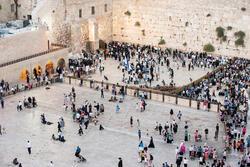Confronting the Mechitza in Hamburg
For most of my life, I remained in places where I was most comfortable, dwelling in spaces of acceptance. I liked experiencing new realities, and there were definitely moments when, by choice or sometimes necessity, I interacted with new and uncomfortable social, academic, and religious experiences, but for the most part, my world was small.
All of this changed when, in 11th grade, I chose to move to Hamburg, Germany, and spend the academic year living with a secular Christian host family. My program's goal was to promote citizen diplomacy, and it aimed to make spaces where American teens could become a part of German society, creating strong bonds with the local population. The main means of accomplishing this was by placing Americans in German households and having them attend the local school. Upon moving, I was suddenly surrounded by newness, forced hourly to interact with others, and made to confront the many facets of my identity. Internally, there were moments of friction as new perspectives mingled with old opinions, but for me, it was when I entered Hamburg's only synagogue that many contradictions really began.
As the High Holidays approached, I confronted the reality that Hamburg has one tiny Jewish community with a single Orthodox synagogue. As is traditional in Orthodox synagogues, women sit separately from men. At this synagogue, separately meant a set of stairs leading to a second-story balcony in the back of the room with no sightline to the bima. I realized that if I wanted a Jewish High Holiday experience, this was my only option.
Before I went to Germany, I grew up in a tight-knit Jewish community on the Upper West Side in New York City attending a Jewish Day School, keeping kosher, observing Shabbat, and regularly reading Torah (leyning) at synagogue. My Judaism was always very connected to my feminist identity, and I prioritized egalitarianism. In fact, since middle school, I have laid tefillin whenever I pray. On different occasions, I'd experienced the many complexities of Jewish observance and the complications with denominational groupings.
I'd always struggled with labels and the pressure to box myself into a denomination, but I mostly stayed within the Conservative movement. For preschool, I originally went to Chabad but quickly switched to the nominally pluralistic school that I would go on to attend for the next 15 years. My Judaism centers on egalitarianism. Still, the Ramah camps where I spent summers and the pluralistic school I attended, however, only required boys to wear tefillin, even in the “supposedly” egalitarian minyan. I've always wrestled with this kind of hypocrisy from supposedly pluralistic and/or Conservative Jewish institutions.
Still, during my childhood, I had many moments where I interacted with other Jewish communities and denominations to various degrees. On the holiday of Simchat Torah, my family would go to different synagogues or, for various B'nai Mitzvahs, would attend services, including ones with a trichitza or partnership minyanim. My grandmother had dragged me to a Hasidic community in Brooklyn a few times, and one of my best friends had an orthodox Bat Mitzvah which I attended. But I always interacted from afar, with the understanding that a non-mechitza, egalitarian space was available just a few moments of displeasure away. There was always a level of comfort in knowing that I didn’t have to look far for a place that fully welcomed me. I had the ability to distance myself from these unfamiliar communities, and there was always, in every situation, a reality of choice.
As I got ready to go to Germany, I began trying to connect with the Hamburg Jewish community. Eventually, I reached the woman who ran many of the religious programs, and she told me how to get a ticket for High Holiday services. Suddenly, I was forced to make decisions that would change my Jewish practice. At home, I never traveled on Shabbat or holidays, but upon realizing that the synagogue was too far away to walk, I compromised that during my year in Germany, I would have to take prepaid trains and buses. It was a hard dynamic of needing, in many ways, to become less religiously observant to accommodate the new living environment, while also balancing the fact that the only religious community was Orthodox. I felt stretched to the verge of breakage, and needless to say when I arrived in Hamburg, this new and unknown place, a week before Rosh Hashanah, I was very nervous.
With no preparation in Hamburg, Germany, for an entire year, I had no choice: I was stuck in a city with only one synagogue and a tiny Jewish community. I had grown up with a plethora of options in a neighborhood littered with synagogues and Jews of every denomination just around the corner. The existence of a Jewish oasis such as this was simply unimaginable in Hamburg. As I entered the synagogue on Rosh Hashanah morning, I immediately noticed the mechitza, or more accurately, the set of stairs. At that moment, the heaviness set in, the reality that I was in a space so far outside of my comfort zone, a place literally built to go against my understanding of feminism and the foundational egalitarian principles my Judaism had always been about. In the wood, the paint, the carpet, I could hear the walls and those stairs screaming at me “you don't belong.” The question “How will I ever find community here?” formed in my mind. Yet, as the chazan started chanting in Hebrew, I felt my knees go weak, and I became dizzy with a sensation of belonging. I felt a deep connection and appreciation for this space and prayer community that was so intensely unlike and against my Jewish practice at home. But here we were, coming together on Rosh Hashanah to recite the same confessions we say at home each year, to read about Abraham, Sarah, Hagar, Ishmael, and Isaac, to stand together, and try to do teshuvah and get it right this year, to repent on Rosh Hashanah.
Since that moment, I have realized that identity is not isolated. There is something powerful in holding that Judaism is both a means of global companionship and a convoluted mess of tradition, culture and deep historic resonance. Despite sitting in that synagogue, with a mechitza so giant and anti-egalitarian, a place I never imagined myself setting foot in, let alone praying in, I was able to find a fragment of home. I realized to never underestimate the unlikely places saturated with foreignness that might just bring you unexpected comfort. There is always a possibility for connection with the unfamiliar, and the only way to know is to engage. Although it can be hard, there is something truly eye-opening in the way uncomfortable environments shape us. They highlight what is lacking, forcing us to realize what we truly value and what brings us genuine joy and connection.
This piece was written as part of JWA’s Rising Voices Fellowship.







